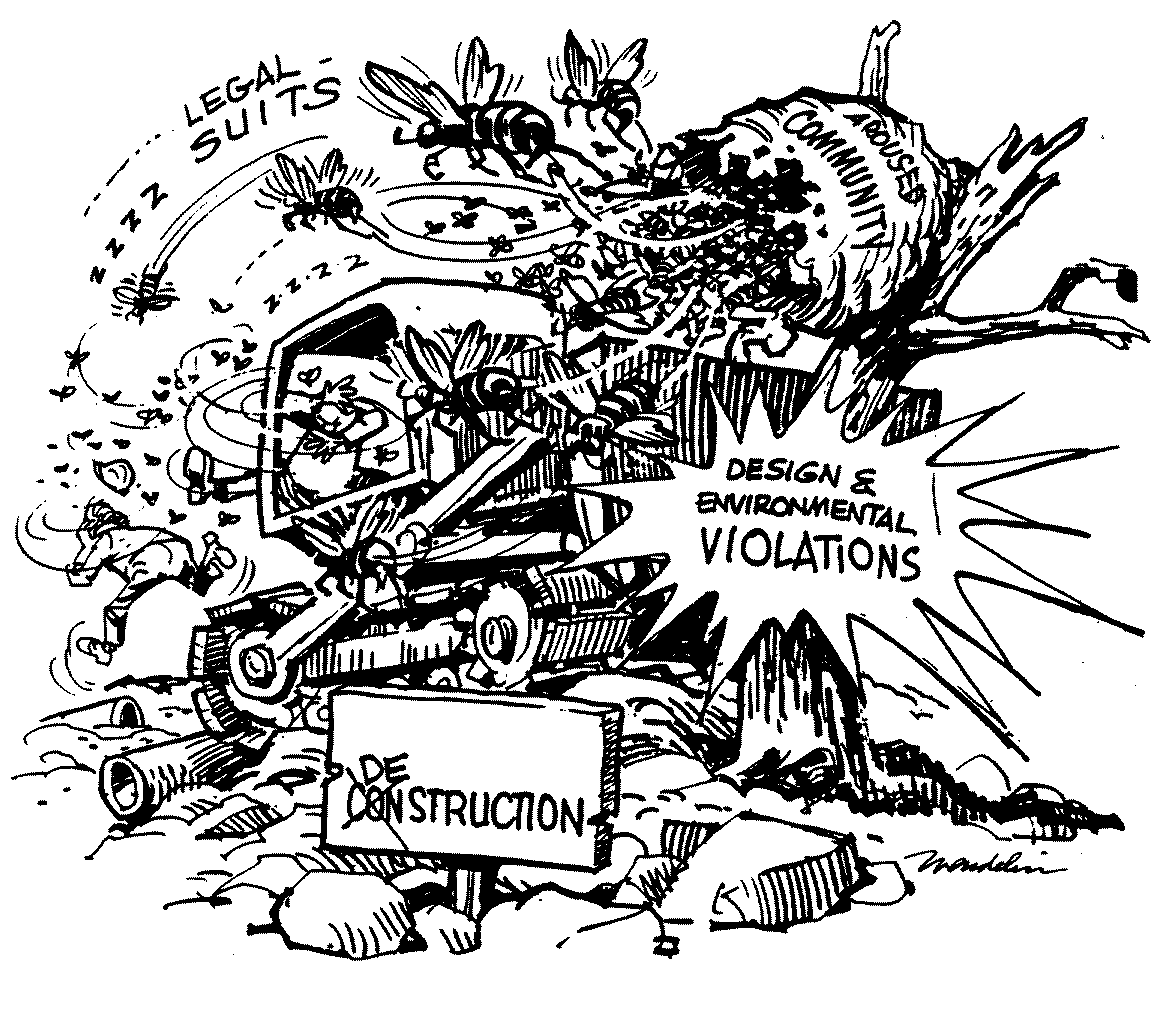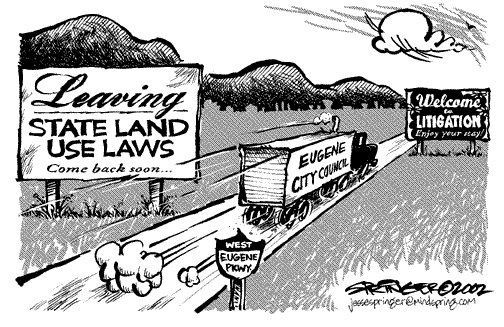WEP: one of the most illegal highways planned
Federal laws: the reason the WEP was canceled
"You must remember one thing. At the Constitutional level where we work, ninety percent of any decision is emotional. The rational part of us supplies the reason for supporting our predilections."
– Charles Evans Hughes, Chief Justice, US Supreme Court
 At the May 29, 2002 Eugene / Springfield / Lane County /
LTD public hearing to amend the TransPlan, West Eugene Wetlands Plan,
Metro Plan and Rural Comprehensive Plan, FHWA Oregon Division administrator
Dave Reilly reminded the officials that federal aid highways cannot
be segmented into smaller pieces to avoid disclosure of the full impact
of the project, require logical termini when approved, must meet a purpose
and need, and must be fiscally constrained.
At the May 29, 2002 Eugene / Springfield / Lane County /
LTD public hearing to amend the TransPlan, West Eugene Wetlands Plan,
Metro Plan and Rural Comprehensive Plan, FHWA Oregon Division administrator
Dave Reilly reminded the officials that federal aid highways cannot
be segmented into smaller pieces to avoid disclosure of the full impact
of the project, require logical termini when approved, must meet a purpose
and need, and must be fiscally constrained.
The City of Eugene summary of his testimony severely downplayed his comments:
"Dave Riley, Federal Highway Administration (FHWA), Salem, reviewed the NEPA process requirements as they related to highway projects in which it had financial involvement. He emphasized the importance of the West Eugene Parkway to the national highway system. Mr. Riley submitted written testimony."
The FHWA testimony did not merely discuss the NEPA process. The agency specifically warned that logical termini, segmentation, fiscal constraint and independent utility were issues that needed to be addressed before they could sign a Record of Decision.
In July, 2002 Eugene, Springfield, Lane County and Lane Transit District amended the West Eugene Wetlands Plan, TransPlan, Metro Plan and Rural Plan to include the West Eugene Parkway, a bypass of the West 11th commercial strip. But approval at the local level does not necessarily mean that it will be built – like all federal aid highways, the ultimate decision will be made by the Federal Highway Administration (FHWA). Some of the hurdles blocking the bulldozers include Oregon’s land use laws (which prohibit new urban freeways outside urban growth boundaries), the National Environmental Policy Act, the Endangered Species Act, FHWA regulations regarding highway approval, the Clean Water Act, and Section 4(f) of the Transportation Act (which prohibits federally funded roads through parks and wildlife refuges).

sympathetic but misleading cartoon -
Oregon State land use laws did not stop WEP
Federal laws signed by Presidents Johnson and Nixon caused its cancellation
| Laws that ODOT must comply with - from Oregon Highway Plan |
General Process Regulations
National Environmental Policy Act 1969 as amended (NEPA)
FHWA Environmental Impact and Related Procedures, 23 CFR 771
Section 4(f) of the Department of Transportation Act of 1966
Occupational Safety and Health Act
Biology, Water Resources, Wetlands
Federal Endangered Species Act - Oregon Endangered Species Act
Federal Clean Water Act and the Oregon Water Quality Standards
Section 404 of the Clean Water Act and Corps Regulations and the Oregon Removal/Fill Law
Location and Hydraulic Design of Encroachments on Floodplains
Executive Memorandum on Landscaping Guidelines
Wild and Scenic Rivers Acts (federal and state)
Cultural, Social, Land Use, Aesthetics
National Historic Preservation Act of 1966
Oregon Historic and Scenic Highways Act
Oregon Land Use Program and Statewide Planning Goals
Uniform Relocation Assistance and Real Property Acquisition Act
Civil Rights Act (Title VI)
Farmland Protection Policy Act
Executive Order 12898 (Environmental Justice)
Noise, Air Quality, and Hazardous Material
FHWA Noise Standard
Federal Clean Air Act Amendments - State and Federal Conformity Rules
Federal Comprehensive Environmental Response, Compensation and Liability Act
Resource Conservation and Recovery Act

| Categorical Exclusions - could be used for smaller version of WETLANDS alternative |
23 CFR 771 Sec. 771.117 Categorical exclusions.
(a) Categorical exclusions (CEs) are actions which meet the definition contained in 40 CFR 1508.4, and, based on past experience with similar actions, do not involve significant environmental impacts. They are actions which: do not induce significant impacts to planned growth or land use for the area, do not require the relocation of significant numbers of people; do not have a significant impact on any natural, cultural, recreational, historic or other resource; do not involve significant air, noise, or water quality impacts; do not have significant impacts on travel patterns; and do not otherwise, either individually or cumulatively, have any significant environmental impacts.
(b) Any action which normally would be classified as a CE but could
involve unusual circumstances will require the Administration, in cooperation
with the applicant, to conduct appropriate environmental studies to determine
if the CE classification is proper. Such unusual circumstances include:
(1) Significant environmental impacts;
(2) Substantial controversy on environmental grounds;
(3) Significant impact on properties protected by Section 4(f) of the
DOT Act or section 106 of the National Historic Preservation Act; or
(4) Inconsistencies with any Federal, State, or local law, requirement
or administrative determination relating to the environmental aspects
of the action.
(d) Additional actions which meet the criteria for a CE in the
CEQ regulations (40 CFR 1508.4) and paragraph (a) of this section
may be designated as CEs only after Administration approval. The applicant
shall submit documentation which demonstrates that the specific conditions
or criteria for these CEs are satisfied and that significant environmental
effects will not result. Examples of such actions include but are not
limited to:
(1) Modernization of a highway by resurfacing, restoration, rehabilitation,
reconstruction, adding shoulders, or adding auxiliary lanes (e.g.,
parking, weaving, turning, climbing).
(2) Highway safety or traffic operations improvement projects including the installation of ramp metering control devices and lighting.
(3) Bridge rehabilitation, reconstruction or replacement or
the construction of grade separation to replace existing at-grade railroad
crossings.
(6) Approvals for disposal of excess right-of-way or
for joint or limited use of right-of-way, where the proposed use does
not have significant adverse impacts.